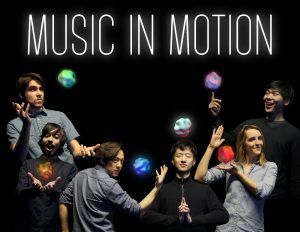The first half of our week was spent completing a prototype that we could demonstrate to our advisor, Heather, prior to her trip to Toronto. This deadline was a helpful preparation for quarters. While we had created some beautiful components, we had not yet tried to pull all of the pieces together into something cohesive. The team was also still struggling with the SuperCollider library and positional sound was not working as of Tuesday evening. For Wednesday, we managed to pull together a demo with a single sound source that used working ambisonics. We also got to see how our main asset, a colorful, rippling sphere or “noise ball”, looked when connected with the physics that had been developed for it in parallel.
Heather had some helpful feedback after reviewing the demo. The experience we presented felt a little playful. The noise ball was very responsive, and object you might want to bat or punch. As a team we will need to decide how to tailor the quality of that movement- what mode of interaction should we encourage? A second concern was that our sound was still very rough. The demo we presented included an annoying “mosquito hum” instead of the rich, organic tones we hoped to present. Finding the correct sounds prior to quarters will be critical to helping us to communicate our concept.

Towards the end of the week we began to nail down some of our deliverables. We finalized the branding materials and spent time discussing our metrics matrix. Audio was of course a top priority on our metric’s list. Quality, spatialized audio will allow us to give our sound presence. Gameplay and interactivity are key, especially with “immersion” in mind. Our hope is that objects and sounds feel integrated enough that guests are lead to our interactions naturally. Some categories, like storytelling and transformational content, were less important, as they are only distantly connect with the goals of the project.
As we approach quarters we are also working on preparing a budget. Spatial sound was one of our primary reasons for taking on this project; we are hoping to put together a 12 speaker ambisonic rig. This will allow us to program and place sounds with their visual components in room scale VR. As we began to research this kind of setup, we discovered that there were some pretty costly requirements. Not only will we need speakers and a mixer, we will also need trusses, clamps, and cabling. Another consideration is sound insulation: the smaller spaces we will be working in are likely to create some distortion. Having pipe and drapes dampen the room reflections could make a significant difference.
While ramping up for quarters and closing out our first sprint, we have begun to recognize a few major concerns. The initial technical setup has been a larger task than expected and we still have a fair amount of leg work ahead of us. We will also need to put a heavier emphasis on playtesting. During this sprint, it took a quite a while to get to the point where we had anything playable. As soon as we have our tooling and pipeline solidified we want to focus more on iteration.
